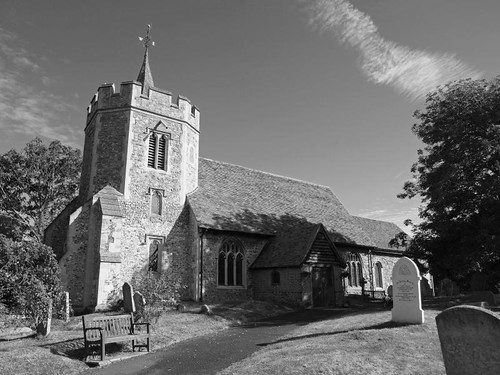Possibly the most interesting, architecturally speaking, of last Thursday's visitation SS Peter & Paul was sadly locked. Its octagonal tower is alluring and its situation is stunning.
ST PETER. Away from the village. A short, unusual W tower with big bulky angle buttresses at the foot and then changing from the square into an irregular octagon. Battlements and recessed spire. The big cusped, ogee-headed W doorway is said to date from the restoration of 1842. The rest of the church is C13. Nave and low, narrow N aisle separated by a four-bay arcade on round piers with stiff-leaf capitals (upright leaves) and one-stepped, slightly single-chamfered arches. Original aisle windows small. The nave roof is ascribed to the C14. It has tie-beams and king-posts with moulded capitals. - FONT. Uncommonly big, octagonal, C13, of the Purbeck type with shallow blank pointed arcades. - PLATE. Cup of 1562 with band of ornament.
HOCKLEY. Its houses are on a hill between a great wood and the valley of the Crouch. We may imagine the Saxons fleeing for safety into the depths of this wood before the vengeance of Canute’s Danes, who on the slopes below had won for their leader the crown of England. The round hillock in the valley was the home of still earlier dwellers in our Motherland, for pottery and a coin of the Roman Emperor Diocletian have been found in it. It was Diocletian who resolved to stamp out Christianity, but one of the first things done by King Canute was to found a church on this hill-top. No Saxon work is traceable today, for the oldest thing we see is the marble font, brought here about the time of Magna Carta, when most of the present church was built. The three round pillars between the nave and aisle have the conventional foliage of that time; the nave roof is 14th century, with well-moulded capitals and kingposts. The curious-looking tower was begun 600 years ago, the lower stage being square and solid; but where the buttresses end it becomes octagonal, with battlernents surrounding a small spire.
Flickr.
Flickr.

No comments:
Post a Comment